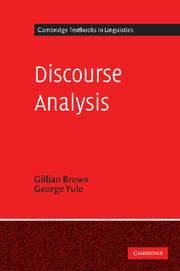Book contents
- Frontmatter
- Contents
- Preface
- Acknowledgements
- Transcription conventions
- 1 Introduction: linguistic forms and functions
- 2 The role of context in interpretation
- 3 Topic and the representation of discourse content
- 4 ‘Staging’ and the representation of discourse structure
- 5 Information structure
- 6 The nature of reference in text and in discourse
- 7 Coherence in the interpretation of discourse
- References
- Subject index
- Author index
5 - Information structure
Published online by Cambridge University Press: 05 June 2012
- Frontmatter
- Contents
- Preface
- Acknowledgements
- Transcription conventions
- 1 Introduction: linguistic forms and functions
- 2 The role of context in interpretation
- 3 Topic and the representation of discourse content
- 4 ‘Staging’ and the representation of discourse structure
- 5 Information structure
- 6 The nature of reference in text and in discourse
- 7 Coherence in the interpretation of discourse
- References
- Subject index
- Author index
Summary
The structure of information
In the previous chapters we have been considering increasingly restricted views of the production and interpretation of discourse. In Chapter 2 we considered the effect of situational context on discourse and in Chapter 3 the effect of different perspectives of topic structure. We devoted Chapter 4 to discussing the effect of linearisation in discourse, how what is presented first limits the interpretation of what follows and how decisions on thematisation provide the overall structure within which the addressee interprets the discourse.
In this chapter we focus in even further, to the smallest units of discourse structure: small local units at the level of phrase or clause. We consider how information is packaged within such small structures and, particularly, what resources are available to speakers and writers for indicating to their addressees the status of information which is introduced into the discourse.
Information structure and the notion ‘given / new’ in intonation
The serious study of information structure within texts was instituted by scholars of the Prague School before the Second World War. They studied what they called ‘the communicative dynamism’ of the elements contributing to a sentence, within the framework of ‘functional sentence perspective’. (For an overview of this work see Vachek, 1966; Firbas, 1974.)
Many of the insights developed by the Prague scholars were first brought to the attention of Western scholars by Halliday in an extremely influential article published in 1967.
Information
- Type
- Chapter
- Information
- Discourse Analysis , pp. 153 - 189Publisher: Cambridge University PressPrint publication year: 1983
